Kyoto’s Spiritual Essence: A Journey Through Its Ancient Temples and Shrines
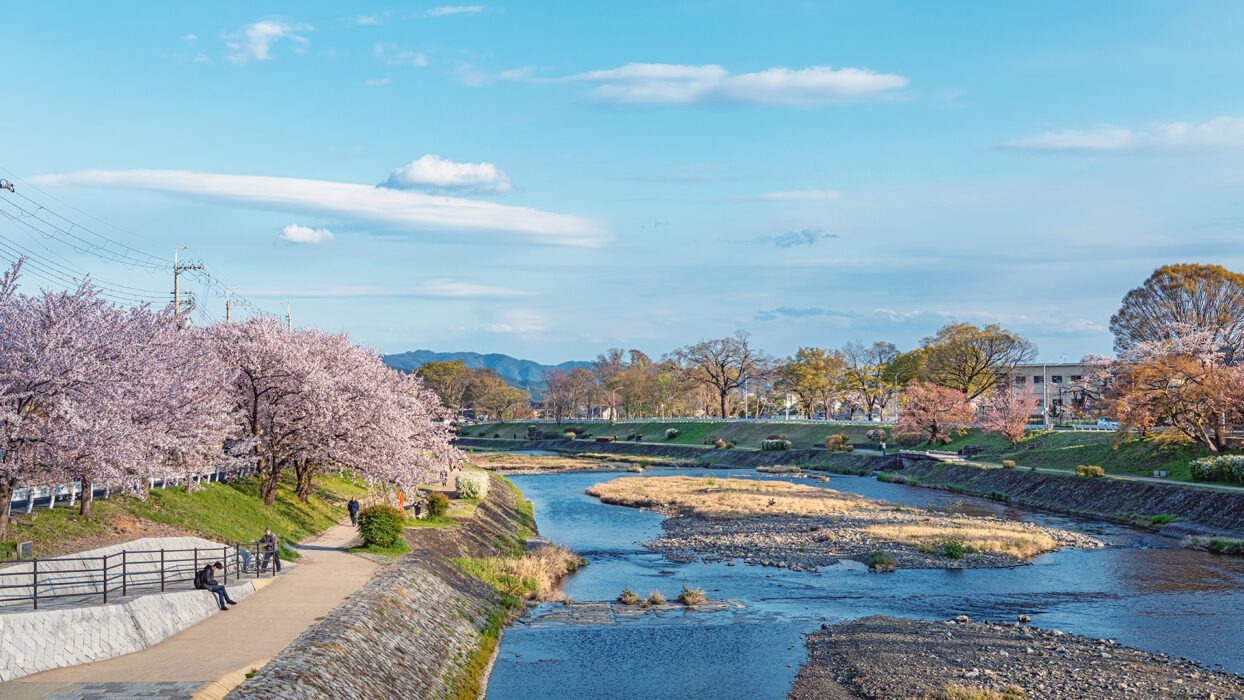
Kyoto’s Rich Cultural and Religious Heritage
Kyoto, the ancient capital of Japan, is a city where history breathes through every alley and temple. This city, renowned for its rich cultural and religious heritage, offers a unique glimpse into the soul of traditional Japan. The spiritual journey through Kyoto is not just about visiting temples and shrines; it’s an immersive experience that connects visitors with the city’s ancient traditions and beliefs. Here, Shinto and Buddhist practices coexist, each contributing to the spiritual tapestry of Kyoto. As you explore the architectural wonders and serene landscapes, you’ll find yourself enveloped in the tranquility and mystical charm that Kyoto is celebrated for.
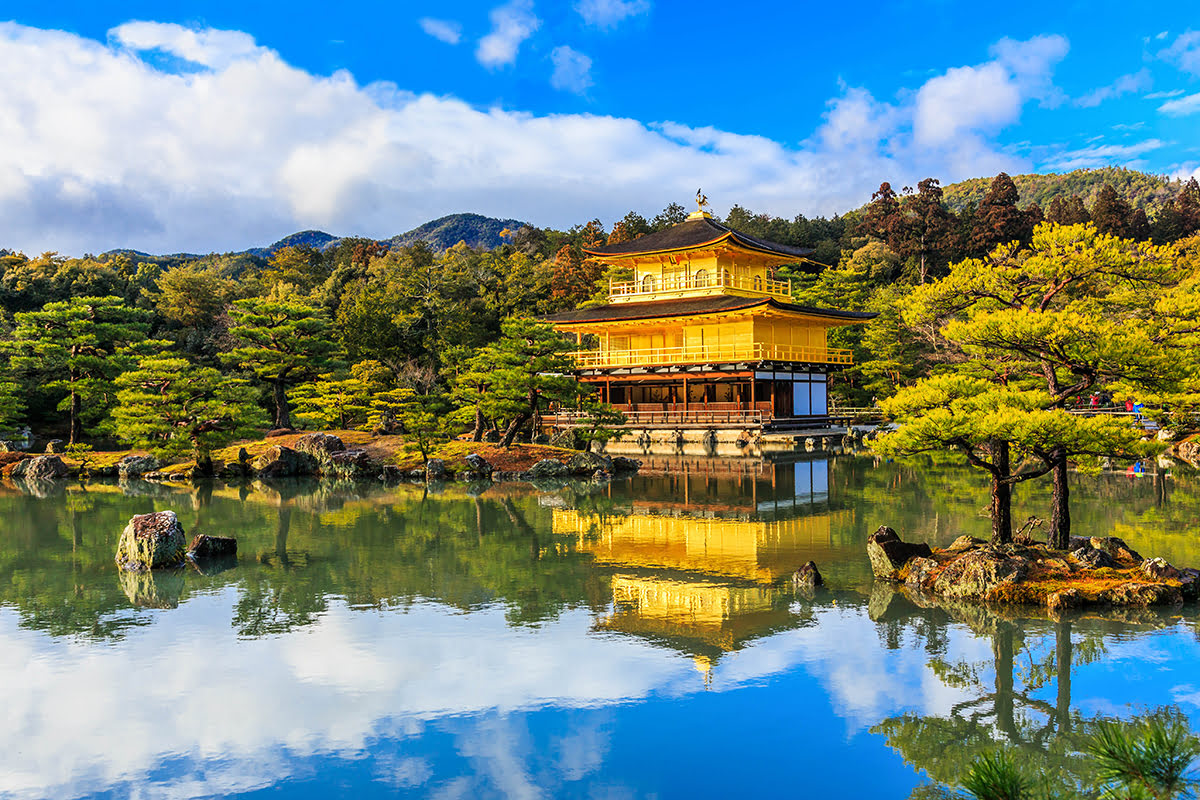
Kinkaku-ji: The Golden Pavilion
Address: 1 Kinkakujicho, Kita Ward, Kyoto, 603-8361, Japan.
The journey begins at Kinkaku-ji, also known as the Golden Pavilion. This iconic Zen Buddhist temple, covered in gold leaf, shimmers against the backdrop of a serene pond, creating a picturesque scene that embodies Kyoto’s extravagant beauty. The pavilion, originally built as a retirement villa for a shogun, later transformed into a Zen temple, is a testament to the lavish Muromachi period. Its reflections in the surrounding waters are not just visually stunning; they symbolize the harmony between heaven and earth, a core concept in Japanese aesthetics. Walking through the meticulously manicured gardens of Kinkaku-ji, visitors can’t help but feel a sense of awe at this architectural marvel.
Plan your stay near this iconic landmark by booking a room through Agoda – Hotels Near Kinkaku-ji
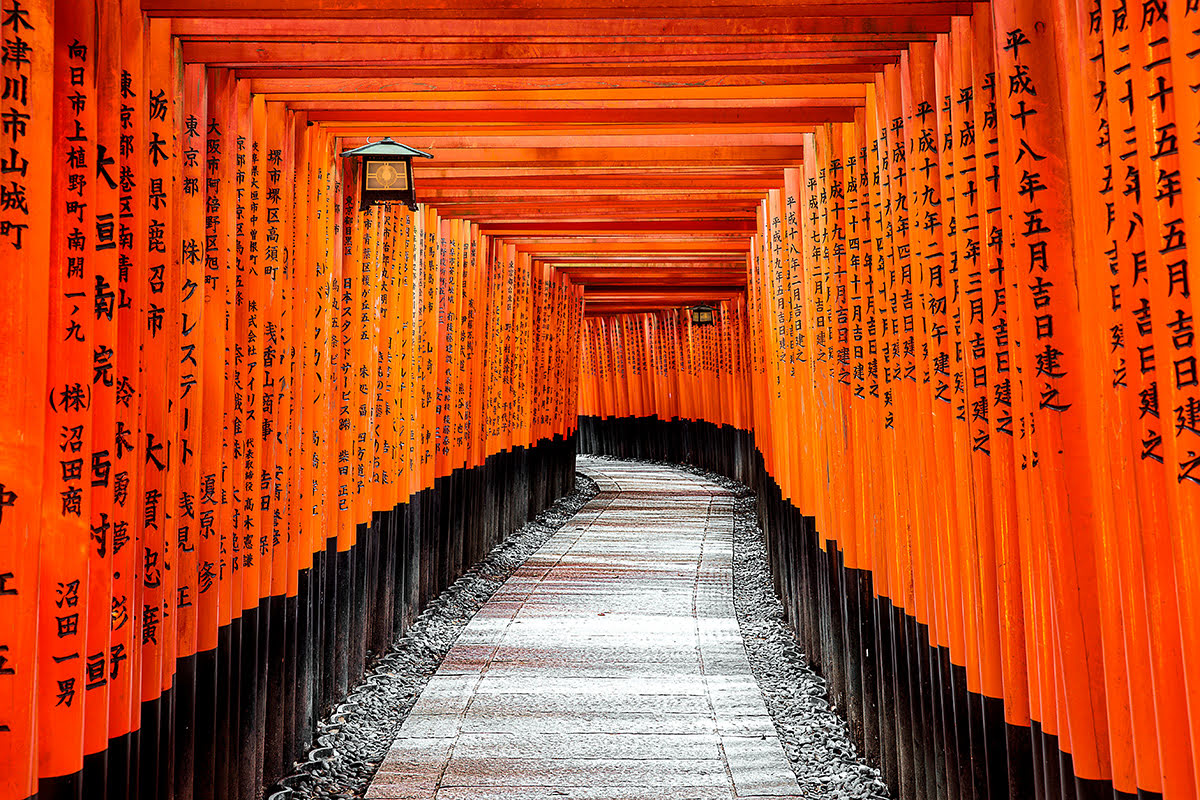
Fushimi Inari Taisha: The Vermillion Path to Spirituality
Address: 68 Fukakusa Yabunouchicho, Fushimi Ward, Kyoto, 612-0882, Japan.
Next on this spiritual journey is Fushimi Inari Taisha, a shrine that captivates with its thousands of bright vermillion torii gates. These gates, forming a tunnel-like path up a mountain, represent the journey to spiritual enlightenment. The shrine, dedicated to Inari, the god of rice and prosperity, is a place where visitors can seek blessings for good fortune. The hike through these gates is not just a physical journey; it’s a meditative experience, with each step taking you deeper into the realm of the divine. The shrine’s connection to agriculture and business reflects the deep-rooted Shinto belief in the sacredness of nature and its bounties.
Experience the tranquility of Fushimi Inari Taisha by staying at a nearby hotel, available at Agoda – Hotels Near Fushimi Inari-taisha Shrine
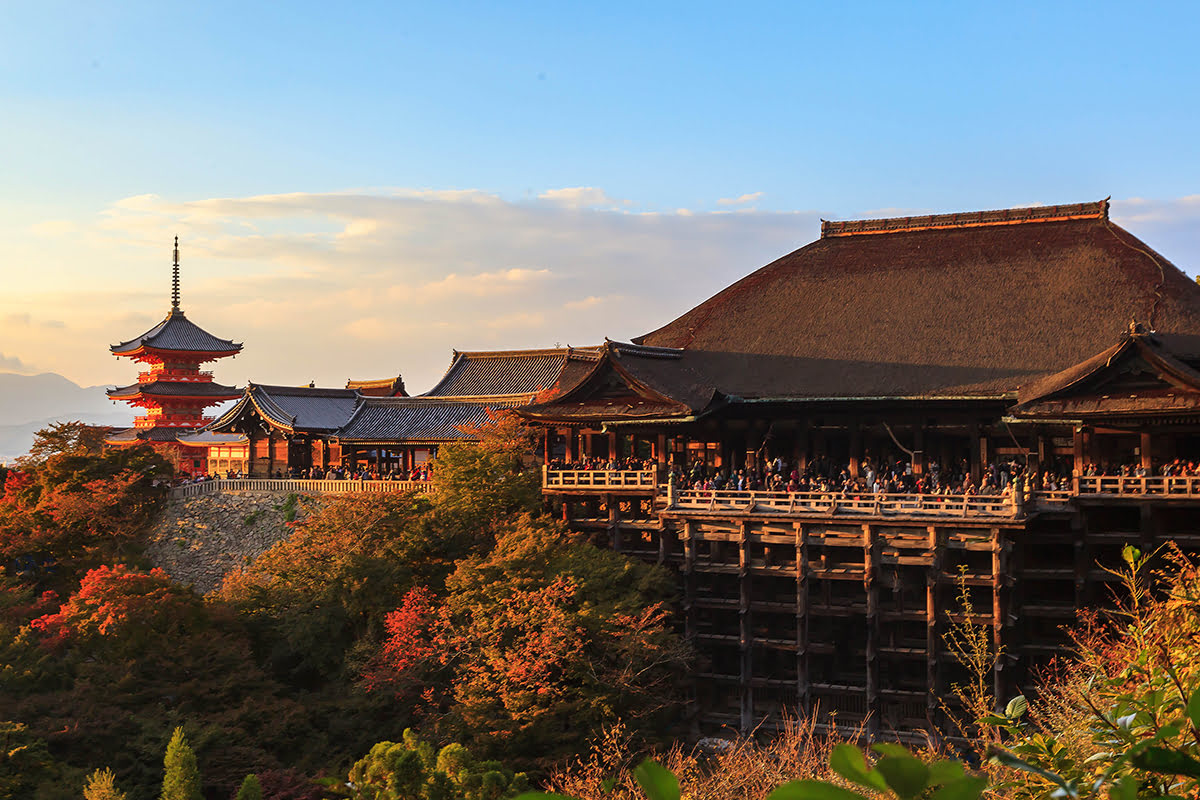
Kiyomizu-dera: The Temple of Pure Water
Address: 294 Kiyomizu, Higashiyama Ward, Kyoto, 605-0862, Japan.
Perched on the eastern hills of Kyoto, Kiyomizu-dera, a UNESCO World Heritage site, offers a panoramic view of the city. Known for its impressive wooden stage, the temple stands without a single nail, a marvel of ancient Japanese engineering. This temple, which translates to “Pure Water Temple,” is centered around the Otowa Waterfall. Visitors often drink from its waters, believed to bring good fortune. The temple’s architecture and its connection to the early days of Buddhism in Japan make it not just a tourist spot but a spiritual haven. The experience of standing on the Kiyomizu Stage, overlooking the city, is both humbling and exhilarating.
Stay close to this historic site by booking your accommodation via Agoda – Hotels Near Kiyomizu-dera
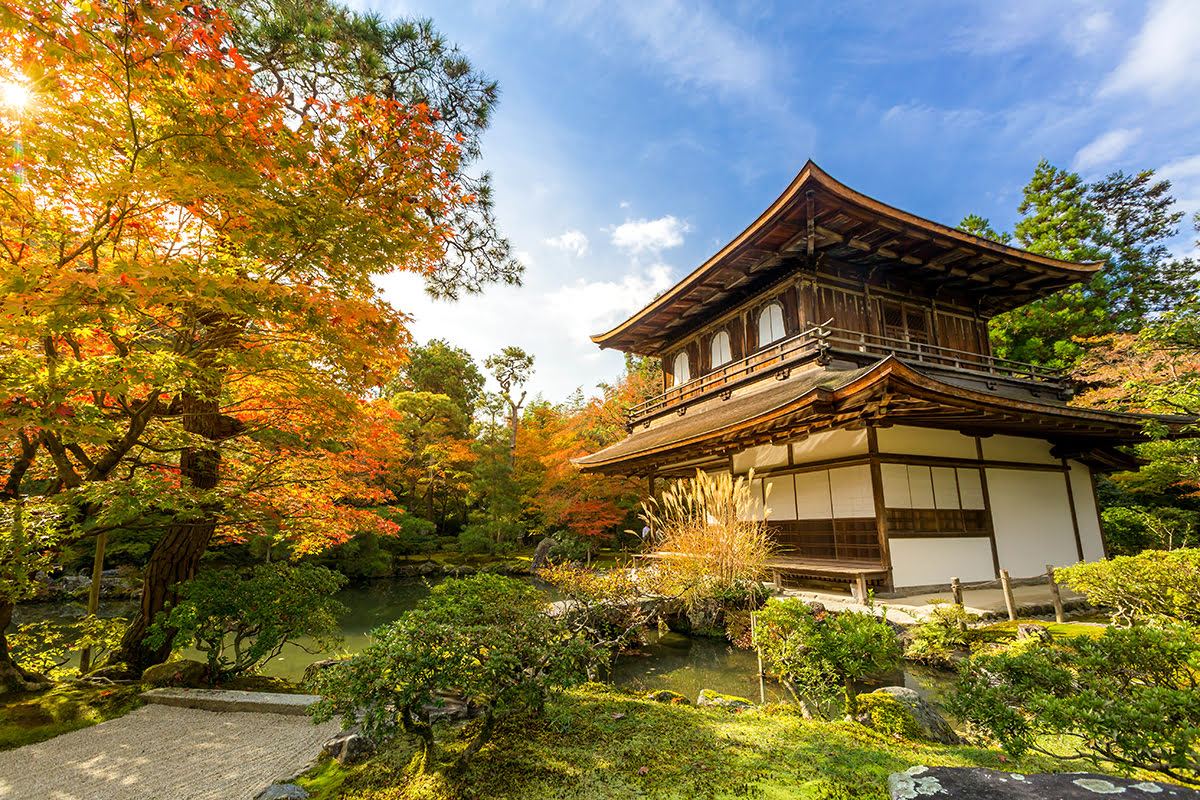
Ginkaku-ji: The Silver Pavilion and its Zen Gardens
Address: 2 Ginkakujicho, Sakyo Ward, Kyoto, 606-8402, Japan.
Ginkaku-ji, the Silver Pavilion, stands as a serene counterpart to the Golden Pavilion. While it may lack the literal gilding of Kinkaku-ji, Ginkaku-ji’s beauty lies in its understated elegance and the meticulously crafted gardens surrounding it. The temple, originally intended to be covered in silver, epitomizes the concept of wabi-sabi, finding beauty in simplicity and impermanence. Strolling through its sand gardens, which symbolize the sea and mountains, visitors are invited to reflect on the transient nature of life. The temple’s architecture, blending seamlessly with the natural landscape, encourages a sense of inner peace and contemplation.
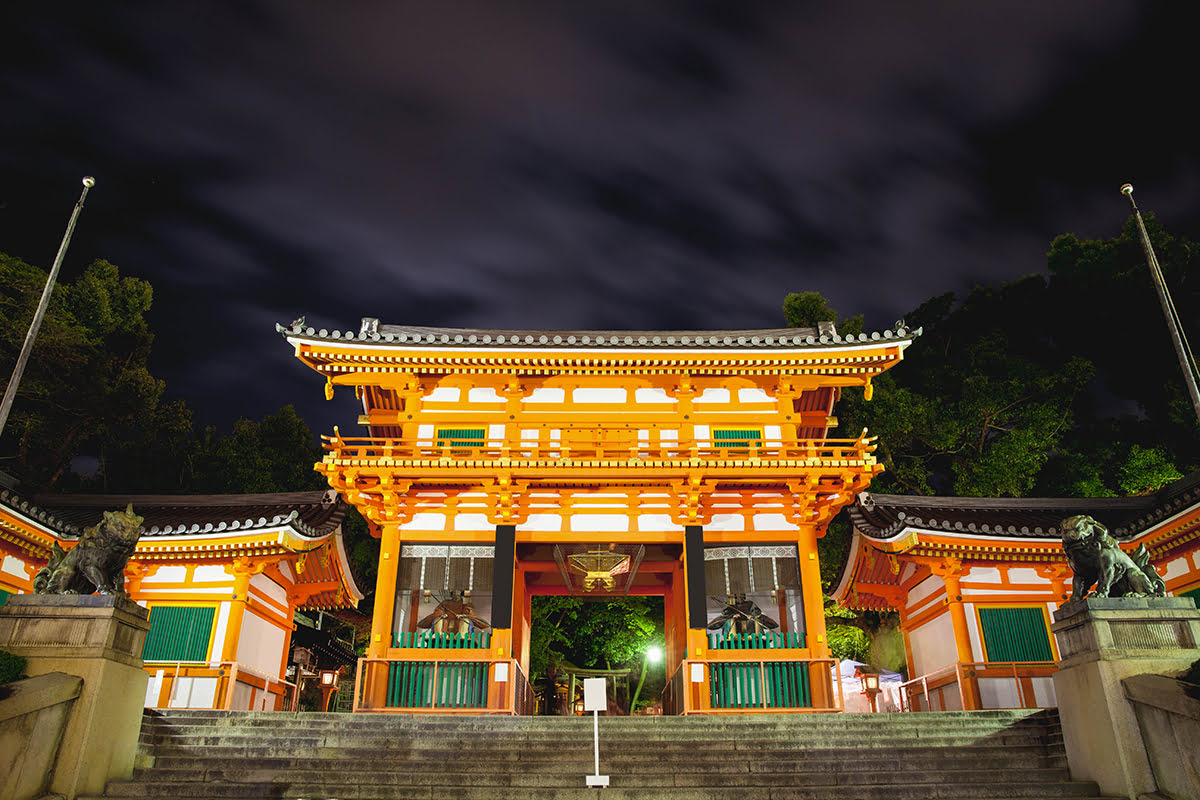
Yasaka Shrine: The Heart of Gion
Address: 625 Gionmachi Kitagawa, Higashiyama Ward, Kyoto, 605-0073, Japan.
In the bustling Gion district, the Yasaka Shrine stands as a beacon of spiritual calm. Known for its summer festival, Gion Matsuri, the shrine is an integral part of Kyoto’s cultural heritage. The architecture of Yasaka Shrine, with its vermilion gates and lanterns, provides a colorful contrast to the traditional wooden machiya houses of Gion. This shrine, dedicated to the god of healing and good fortune, is a place where the ancient and modern worlds of Kyoto intersect. The lively atmosphere of Gion, with its maiko and geiko (geisha), adds a unique charm to the shrine, making it a must-visit for anyone seeking to experience Kyoto’s living traditions.

Ryoan-ji: The Zen Rock Garden
Address: 13 Ryoanji Goryonoshitacho, Ukyo Ward, Kyoto, 616-8001, Japan.
Ryoan-ji is renowned for its karesansui (dry landscape) rock garden, an embodiment of Zen Buddhist philosophy. The fifteen rocks, meticulously arranged and surrounded by raked gravel, stimulate meditation and introspection. This Zen temple’s rock garden is a puzzle, with only fourteen rocks visible from any angle, symbolizing the imperfection and incompleteness inherent in life. The simplicity of Ryoan-ji’s design and the peaceful ambiance of its surroundings invite visitors to disconnect from the outside world and engage in a moment of quiet reflection. The temple’s minimalist aesthetic is a reminder of the Zen principle of less is more, a concept deeply ingrained in Japanese culture.
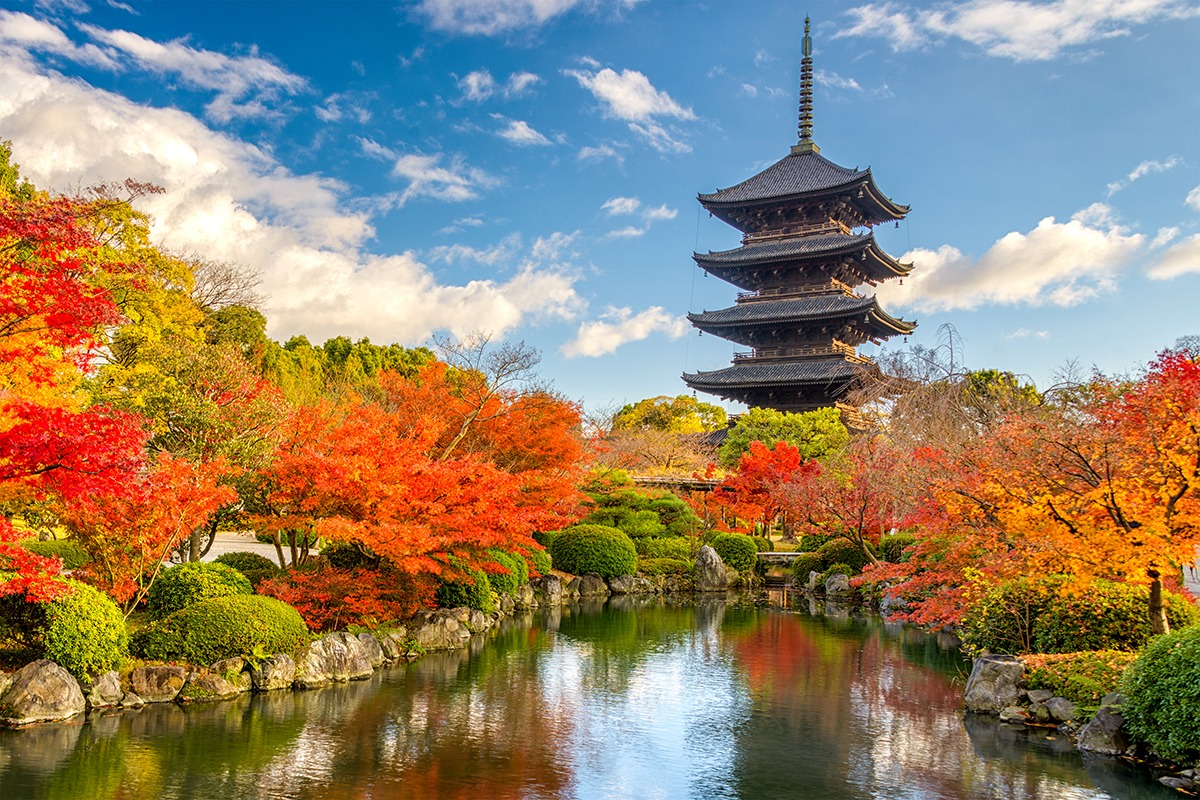
To-ji: The Symbol of Spiritual Ascent
Address: 1 Kujocho, Minami Ward, Kyoto, 601-8473, Japan.
To-ji, home to Kyoto’s tallest pagoda, is a symbol of spiritual and cultural resilience. This five-story pagoda, a representation of the five elements of Buddhist cosmology, dominates Kyoto’s skyline, reminding visitors of the city’s Buddhist heritage. The temple grounds, a blend of solemnity and serenity, allow for a deep spiritual connection. To-ji, which translates to East Temple, holds significant historical value, having been founded shortly after the capital was moved to Kyoto. The pagoda, along with the temple’s array of sculptures and artworks, provides a tangible connection to the Heian period, offering insights into the religious and cultural landscape of ancient Japan.
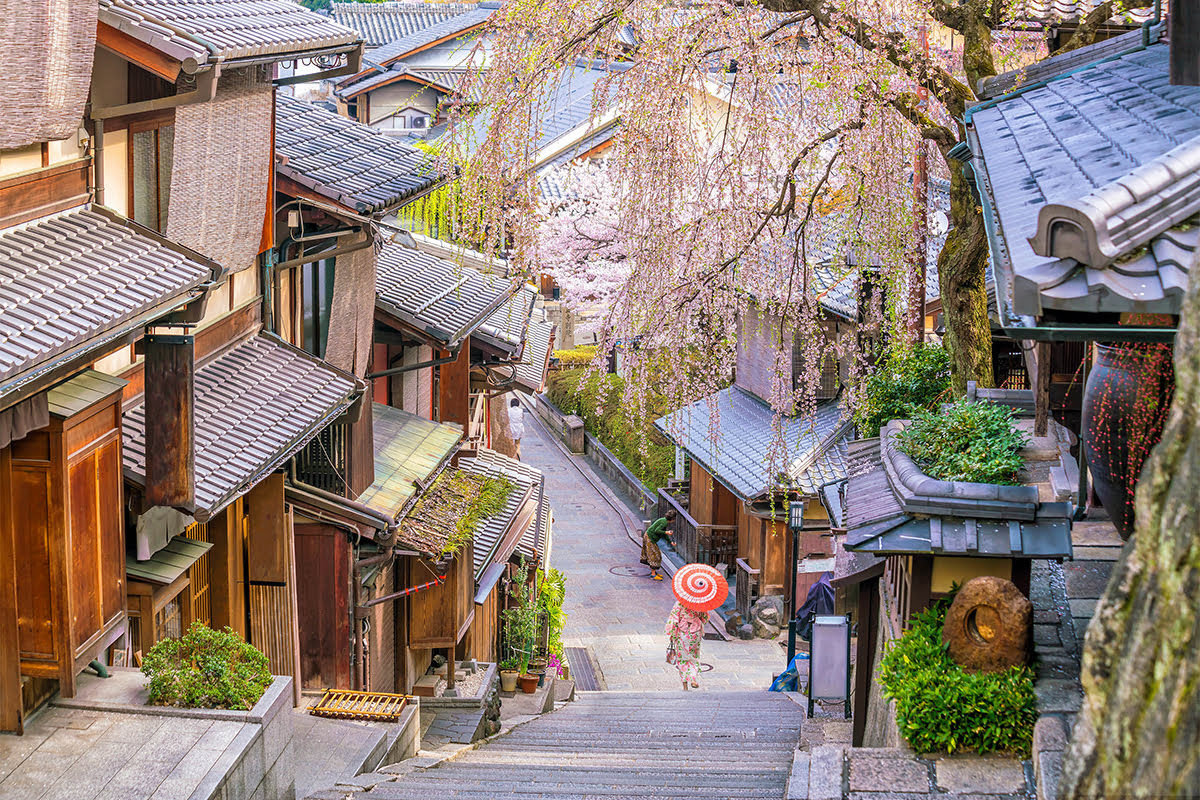
Exploring the Higashiyama District
The Higashiyama district, with its narrow lanes and traditional wooden buildings, is a journey back in time. This area is home to several of Kyoto’s most famous temples, including Kiyomizu-dera and Kodai-ji. The district’s traditional shops and teahouses offer a glimpse into old Kyoto. A visit to the nearby Kyoto National Museum adds a scholarly depth to your exploration, with its collections of art and artifacts showcasing the city’s rich cultural heritage. The museum, housed in a stunning Meiji-era building, provides context to the temples and shrines of Kyoto, linking their spiritual significance to the broader tapestry of Japanese history.
Find the perfect place to stay in this historic district through Agoda – Hotels in Higashiyama District
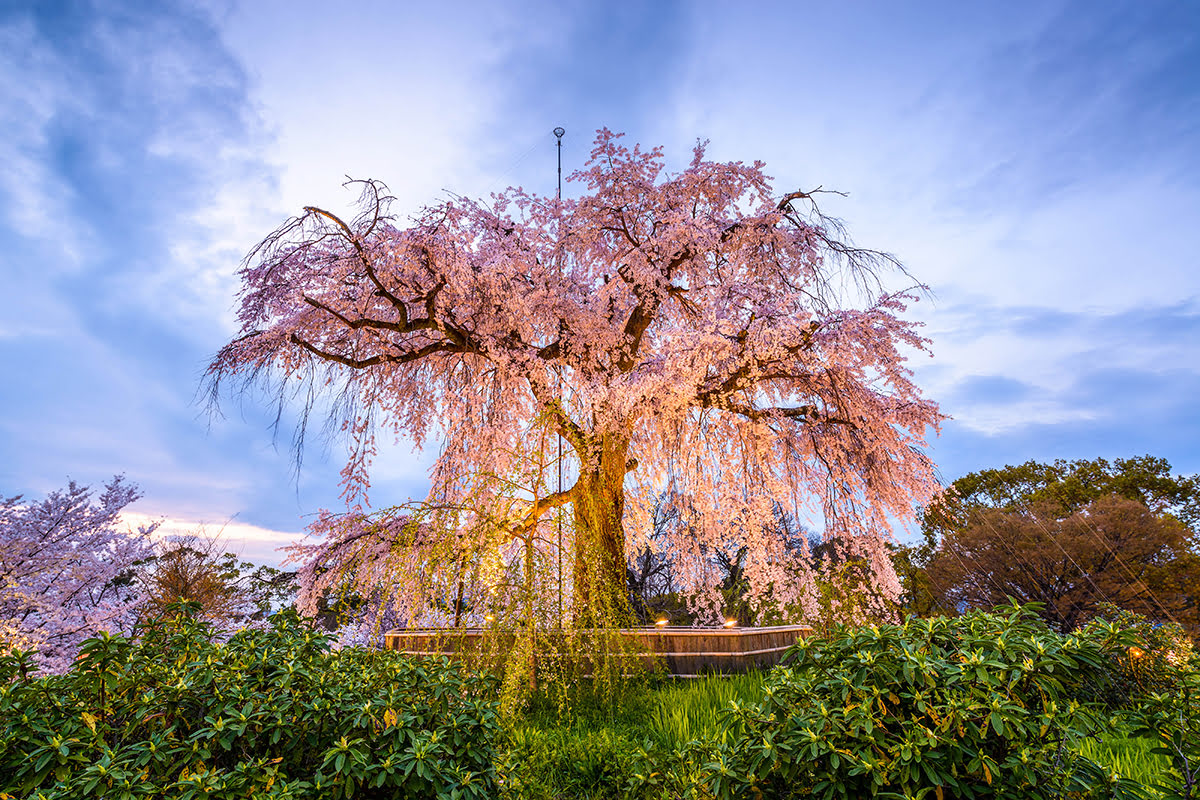
Seasonal Celebrations and Festivals
Kyoto’s temples and shrines are not just static monuments to the past; they are vibrant centers of contemporary cultural life. The city’s calendar is marked by an array of festivals and celebrations, each tied to the changing seasons. Spring brings the famous Hanami (cherry blossom viewing) at spots like Maruyama Park near Yasaka Shrine, where the delicate sakura blossoms create a dreamlike canopy. Autumn transforms the city into a palette of fiery reds and oranges, particularly striking at Tofuku-ji and Eikando temples. These seasonal transformations are not just visually stunning; they’re deeply ingrained in the cultural and spiritual life of Kyoto, offering visitors a chance to partake in centuries-old traditions.
You may also like
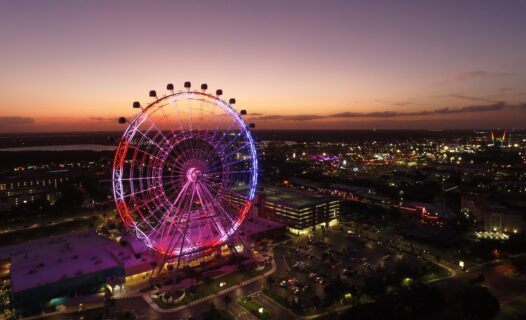
Embark on a culinary adventure in Orlando! From exquisite fine dining and vibrant food trucks to sustainable eats and lively festivals, discover the flavors that make Orlando a foodie's paradise.

Dive into the ultimate Nha Trang shopping adventure! Explore bustling markets, chic boutiques, eco-friendly finds, and seasonal events in our detailed guide.
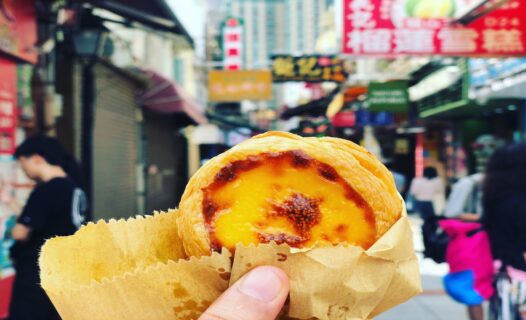
Embark on a culinary journey through Macau with our ultimate guide to its fusion flavors. Discover traditional dishes, insider dining tips, and vibrant food festivals that celebrate the best of Macanese cuisine.
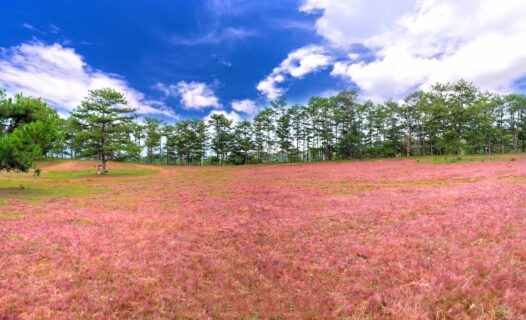
Dive into our captivating 3-Day Dalat Itinerary to uncover Vietnam's highlands gem. From serene lakes to historic sites, embrace adventure & relaxation in Dalat.

Embark on a captivating 7-day journey through Sydney, Australia. From iconic landmarks like the Opera House to the serene Blue Mountains and vibrant Darling Harbour, discover the best attractions the Harbour City has to offer.

Embark on a captivating 5-day journey through Istanbul, exploring historic wonders and cultural gems. Discover itineraries filled with majestic palaces, vibrant bazaars, and scenic cruises.

Embark on a delectable journey through Goa's culinary landscape with our comprehensive guide. Discover traditional Goan cuisine's fusion of flavors, from spicy vindaloos to sweet bebinca, and dive into local culture through markets, cooking classes, and sustainable dining.
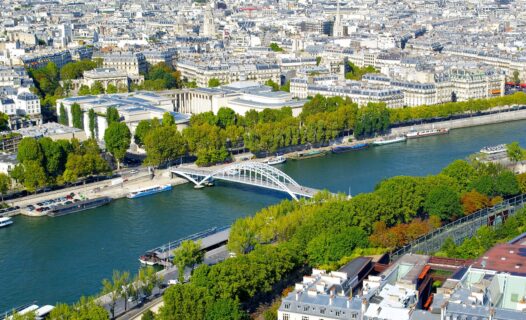
Discover the charm of Paris' arrondissements with our ultimate travel guide. From the historic heart of the city to hidden gems, find the perfect stay for every traveler.
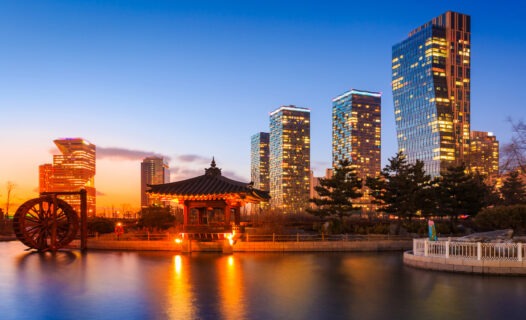
Uncover the best of Incheon in 5 days, from awe-inspiring historic sites to state-of-the-art modern marvels. Indulge in cultural tours, culinary delights, and breathtaking scenery.
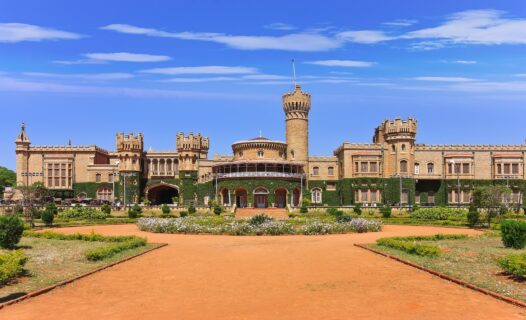
Dive into our 3 Days in Bangalore Itinerary to uncover the best of the Garden City. From royal palaces to tech hubs, enjoy a blend of culture, history, and nature.

Dive into our exclusive 7-Day Krabi Itinerary on Agoda’s Travel Guide. Discover pristine beaches, lush jungles, and cultural treasures in Thailand's paradise.

Embark on an extraordinary weekend getaway in Yilan with our curated itinerary. Discover lush landscapes, soak in natural hot springs, and indulge in local culinary delights.
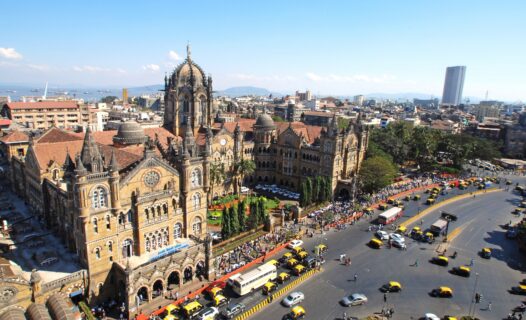
Dive into Mumbai's vibrant culture, history, and flavors with our detailed 3-day itinerary. Discover iconic landmarks, hidden gems, and culinary delights.

Embark on a 7-day journey through Hua Hin/Cha-am with our expertly crafted itinerary. Discover pristine beaches, royal palaces, and hidden gems.
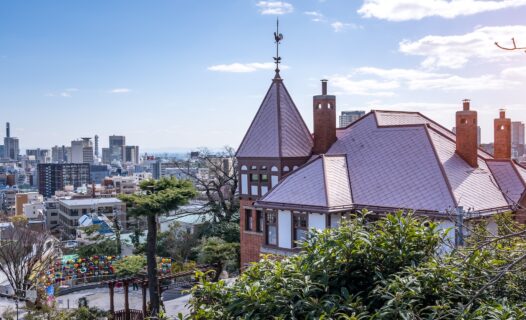
Embark on a captivating 3-day journey through Kobe, Japan. From historical landmarks to scenic beauty, discover the best of Kobe.

Uncover the best of Dallas with our exclusive 3-day itinerary. From iconic landmarks to hidden gems, discover why Dallas, TX, is a must-visit destination.

Discover the best of Hat Yai with our 5-day itinerary. From bustling markets to serene temples, experience the hidden gems of Southern Thailand.

Dive into our 5-day Nha Trang itinerary designed for adventure seekers! From island-hopping to scuba diving and cultural wonders, discover the best of Nha Trang with our expert guide.
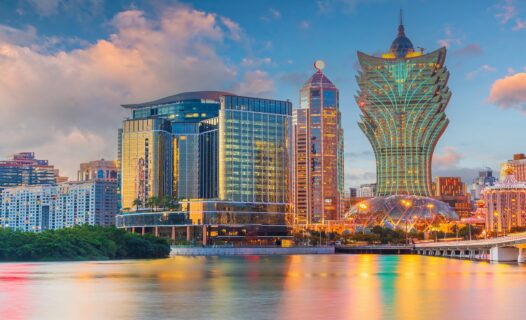
Dive into our engaging 3-Day Macau Itinerary to uncover the vibrant mix of history, culture, and exhilaration in Asia's Vegas.

Dive into Ipoh's culinary paradise with our 3-day food lover's guide! Discover the best eats, hidden cafes, and cultural delights in Malaysia's gastronomic haven.

Unveil the magic of Orlando with our exclusive weekend getaway itinerary! From thrilling theme parks to serene gardens and vibrant nightlife, discover top attractions and local hidden gems.

Kyoto’s Rich Cultural and Religious Heritage
Kyoto, the ancient capital of Japan, is a city where history breathes through every alley and temple. This city, renowned for its rich cultural and religious heritage, offers a unique glimpse into the soul of traditional Japan. The spiritual journey through Kyoto is not just about visiting temples and shrines; it’s an immersive experience that connects visitors with the city’s ancient traditions and beliefs. Here, Shinto and Buddhist practices coexist, each contributing to the spiritual tapestry of Kyoto. As you explore the architectural wonders and serene landscapes, you’ll find yourself enveloped in the tranquility and mystical charm that Kyoto is celebrated for.

Kinkaku-ji: The Golden Pavilion
Address: 1 Kinkakujicho, Kita Ward, Kyoto, 603-8361, Japan.
The journey begins at Kinkaku-ji, also known as the Golden Pavilion. This iconic Zen Buddhist temple, covered in gold leaf, shimmers against the backdrop of a serene pond, creating a picturesque scene that embodies Kyoto’s extravagant beauty. The pavilion, originally built as a retirement villa for a shogun, later transformed into a Zen temple, is a testament to the lavish Muromachi period. Its reflections in the surrounding waters are not just visually stunning; they symbolize the harmony between heaven and earth, a core concept in Japanese aesthetics. Walking through the meticulously manicured gardens of Kinkaku-ji, visitors can’t help but feel a sense of awe at this architectural marvel.
Plan your stay near this iconic landmark by booking a room through Agoda – Hotels Near Kinkaku-ji

Fushimi Inari Taisha: The Vermillion Path to Spirituality
Address: 68 Fukakusa Yabunouchicho, Fushimi Ward, Kyoto, 612-0882, Japan.
Next on this spiritual journey is Fushimi Inari Taisha, a shrine that captivates with its thousands of bright vermillion torii gates. These gates, forming a tunnel-like path up a mountain, represent the journey to spiritual enlightenment. The shrine, dedicated to Inari, the god of rice and prosperity, is a place where visitors can seek blessings for good fortune. The hike through these gates is not just a physical journey; it’s a meditative experience, with each step taking you deeper into the realm of the divine. The shrine’s connection to agriculture and business reflects the deep-rooted Shinto belief in the sacredness of nature and its bounties.
Experience the tranquility of Fushimi Inari Taisha by staying at a nearby hotel, available at Agoda – Hotels Near Fushimi Inari-taisha Shrine

Kiyomizu-dera: The Temple of Pure Water
Address: 294 Kiyomizu, Higashiyama Ward, Kyoto, 605-0862, Japan.
Perched on the eastern hills of Kyoto, Kiyomizu-dera, a UNESCO World Heritage site, offers a panoramic view of the city. Known for its impressive wooden stage, the temple stands without a single nail, a marvel of ancient Japanese engineering. This temple, which translates to “Pure Water Temple,” is centered around the Otowa Waterfall. Visitors often drink from its waters, believed to bring good fortune. The temple’s architecture and its connection to the early days of Buddhism in Japan make it not just a tourist spot but a spiritual haven. The experience of standing on the Kiyomizu Stage, overlooking the city, is both humbling and exhilarating.
Stay close to this historic site by booking your accommodation via Agoda – Hotels Near Kiyomizu-dera

Ginkaku-ji: The Silver Pavilion and its Zen Gardens
Address: 2 Ginkakujicho, Sakyo Ward, Kyoto, 606-8402, Japan.
Ginkaku-ji, the Silver Pavilion, stands as a serene counterpart to the Golden Pavilion. While it may lack the literal gilding of Kinkaku-ji, Ginkaku-ji’s beauty lies in its understated elegance and the meticulously crafted gardens surrounding it. The temple, originally intended to be covered in silver, epitomizes the concept of wabi-sabi, finding beauty in simplicity and impermanence. Strolling through its sand gardens, which symbolize the sea and mountains, visitors are invited to reflect on the transient nature of life. The temple’s architecture, blending seamlessly with the natural landscape, encourages a sense of inner peace and contemplation.

Yasaka Shrine: The Heart of Gion
Address: 625 Gionmachi Kitagawa, Higashiyama Ward, Kyoto, 605-0073, Japan.
In the bustling Gion district, the Yasaka Shrine stands as a beacon of spiritual calm. Known for its summer festival, Gion Matsuri, the shrine is an integral part of Kyoto’s cultural heritage. The architecture of Yasaka Shrine, with its vermilion gates and lanterns, provides a colorful contrast to the traditional wooden machiya houses of Gion. This shrine, dedicated to the god of healing and good fortune, is a place where the ancient and modern worlds of Kyoto intersect. The lively atmosphere of Gion, with its maiko and geiko (geisha), adds a unique charm to the shrine, making it a must-visit for anyone seeking to experience Kyoto’s living traditions.

Ryoan-ji: The Zen Rock Garden
Address: 13 Ryoanji Goryonoshitacho, Ukyo Ward, Kyoto, 616-8001, Japan.
Ryoan-ji is renowned for its karesansui (dry landscape) rock garden, an embodiment of Zen Buddhist philosophy. The fifteen rocks, meticulously arranged and surrounded by raked gravel, stimulate meditation and introspection. This Zen temple’s rock garden is a puzzle, with only fourteen rocks visible from any angle, symbolizing the imperfection and incompleteness inherent in life. The simplicity of Ryoan-ji’s design and the peaceful ambiance of its surroundings invite visitors to disconnect from the outside world and engage in a moment of quiet reflection. The temple’s minimalist aesthetic is a reminder of the Zen principle of less is more, a concept deeply ingrained in Japanese culture.

To-ji: The Symbol of Spiritual Ascent
Address: 1 Kujocho, Minami Ward, Kyoto, 601-8473, Japan.
To-ji, home to Kyoto’s tallest pagoda, is a symbol of spiritual and cultural resilience. This five-story pagoda, a representation of the five elements of Buddhist cosmology, dominates Kyoto’s skyline, reminding visitors of the city’s Buddhist heritage. The temple grounds, a blend of solemnity and serenity, allow for a deep spiritual connection. To-ji, which translates to East Temple, holds significant historical value, having been founded shortly after the capital was moved to Kyoto. The pagoda, along with the temple’s array of sculptures and artworks, provides a tangible connection to the Heian period, offering insights into the religious and cultural landscape of ancient Japan.

Exploring the Higashiyama District
The Higashiyama district, with its narrow lanes and traditional wooden buildings, is a journey back in time. This area is home to several of Kyoto’s most famous temples, including Kiyomizu-dera and Kodai-ji. The district’s traditional shops and teahouses offer a glimpse into old Kyoto. A visit to the nearby Kyoto National Museum adds a scholarly depth to your exploration, with its collections of art and artifacts showcasing the city’s rich cultural heritage. The museum, housed in a stunning Meiji-era building, provides context to the temples and shrines of Kyoto, linking their spiritual significance to the broader tapestry of Japanese history.
Find the perfect place to stay in this historic district through Agoda – Hotels in Higashiyama District

Seasonal Celebrations and Festivals
Kyoto’s temples and shrines are not just static monuments to the past; they are vibrant centers of contemporary cultural life. The city’s calendar is marked by an array of festivals and celebrations, each tied to the changing seasons. Spring brings the famous Hanami (cherry blossom viewing) at spots like Maruyama Park near Yasaka Shrine, where the delicate sakura blossoms create a dreamlike canopy. Autumn transforms the city into a palette of fiery reds and oranges, particularly striking at Tofuku-ji and Eikando temples. These seasonal transformations are not just visually stunning; they’re deeply ingrained in the cultural and spiritual life of Kyoto, offering visitors a chance to partake in centuries-old traditions.
You may also like












